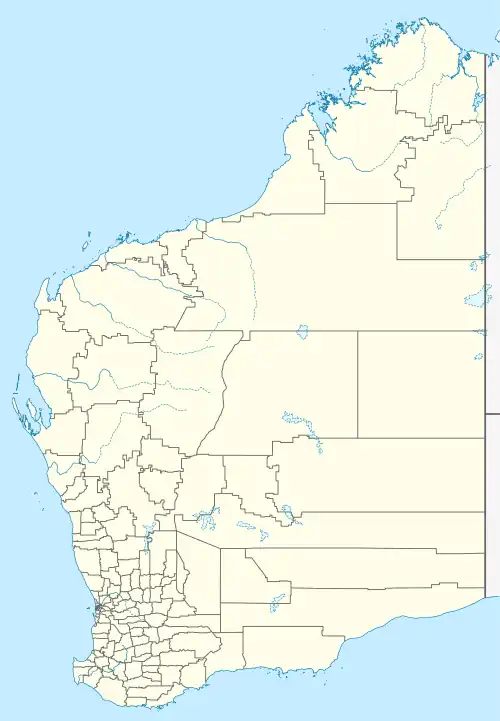| Bakers Hill Western Australia | |||||||||
|---|---|---|---|---|---|---|---|---|---|
 Bakers Hill | |||||||||
 Bakers Hill | |||||||||
| Coordinates | 31°45′04″S 116°27′18″E / 31.751°S 116.455°E | ||||||||
| Population | 792 (UCL 2021)[1] | ||||||||
| Established | 1897 | ||||||||
| Postcode(s) | 6562 | ||||||||
| Elevation | 330 m (1,083 ft) | ||||||||
| Area | 83.9 km2 (32.4 sq mi) | ||||||||
| Location | |||||||||
| LGA(s) | Shire of Northam | ||||||||
| State electorate(s) | Central Wheatbelt | ||||||||
| Federal division(s) | Pearce | ||||||||
| |||||||||
Bakers Hill is a town 73 kilometres (45 mi) east of Perth, Western Australia on the Great Eastern Highway. The town is located within the Shire of Northam, between Wundowie and Clackline. At the 2021 census, Bakers Hill had a population of 1276.
History
The town was originally known as Mount Baker when it was established in 1897.[2] In 1902, the name was changed to Baker's Hill to avoid confusion with the town of Mount Barker in the Great Southern area. The apostrophe was removed from the name in 1944.[3]
Military history
During World War II, Bakers Hill was the location of the 62nd Field Park Company of the Royal Australian Engineers (RAE).[4]
Railways
Bakers Hill was also a station and siding on the second route of the Eastern Railway between Midland Junction and Spencers Brook. This track was closed in 1966 when the route through the Avon Valley was opened.[5]
Although the rail was removed in 1980, remnants of the old station platform are still visible.[6]

Climate
Bakers Hill has a Mediterranean climate with hot dry summers and cool, rather wet winters.
| Climate data for Bakers Hill | |||||||||||||
|---|---|---|---|---|---|---|---|---|---|---|---|---|---|
| Month | Jan | Feb | Mar | Apr | May | Jun | Jul | Aug | Sep | Oct | Nov | Dec | Year |
| Record high °C (°F) | 43.2 (109.8) |
44.6 (112.3) |
40.0 (104.0) |
37.8 (100.0) |
33.3 (91.9) |
24.2 (75.6) |
23.3 (73.9) |
27.0 (80.6) |
31.7 (89.1) |
36.6 (97.9) |
39.8 (103.6) |
42.0 (107.6) |
44.6 (112.3) |
| Mean daily maximum °C (°F) | 31.8 (89.2) |
31.7 (89.1) |
28.5 (83.3) |
23.5 (74.3) |
19.2 (66.6) |
16.0 (60.8) |
15.1 (59.2) |
15.6 (60.1) |
17.5 (63.5) |
21.7 (71.1) |
25.6 (78.1) |
29.9 (85.8) |
23.0 (73.4) |
| Mean daily minimum °C (°F) | 15.7 (60.3) |
16.1 (61.0) |
14.6 (58.3) |
12.3 (54.1) |
9.4 (48.9) |
7.6 (45.7) |
6.6 (43.9) |
6.4 (43.5) |
7.0 (44.6) |
8.9 (48.0) |
11.2 (52.2) |
14.0 (57.2) |
10.8 (51.4) |
| Record low °C (°F) | 7.8 (46.0) |
7.2 (45.0) |
6.2 (43.2) |
4.0 (39.2) |
2.4 (36.3) |
0.2 (32.4) |
0.6 (33.1) |
−2.9 (26.8) |
0.2 (32.4) |
0.5 (32.9) |
1.7 (35.1) |
5.5 (41.9) |
−2.9 (26.8) |
| Average precipitation mm (inches) | 16.0 (0.63) |
13.0 (0.51) |
17.4 (0.69) |
30.6 (1.20) |
71.1 (2.80) |
110.4 (4.35) |
113.7 (4.48) |
86.3 (3.40) |
64.0 (2.52) |
33.9 (1.33) |
20.8 (0.82) |
10.2 (0.40) |
581.3 (22.89) |
| Average precipitation days | 2.1 | 2.4 | 2.9 | 6.0 | 10.2 | 14.2 | 14.9 | 13.7 | 11.6 | 6.9 | 4.4 | 2.3 | 91.6 |
| Source: [7] | |||||||||||||
References
- ↑ Australian Bureau of Statistics (28 June 2022). "Bakers Hill (urban centre and locality)". Australian Census 2021.
- ↑ Western Australia. Department of Lands and Surveys (1897), Mount Baker suburban area, Dept. of Lands & Surveys W.A, retrieved 24 September 2022
- ↑ "History of country town names – B". Western Australian Land Information Authority. Archived from the original on 14 March 2022. Retrieved 8 June 2007.
- ↑ Graham McKenzie-Smith The Unit Guide entry 3.504 identified the presence between November 1942 - November 1943 McKenzie-Smith, Graham Robert (2018), The unit guide : the Australian Army 1939-1945, Big Sky Publishing, ISBN 978-1-925675-14-6
- ↑ Zeplin, N (1967) The Avon Valley Deviation Australian Railway Historical Society Bulletin, December 1967 pp253-265
- ↑ Copley, Don (27 January 2005). "Stations, Sidings and Railway Locations Of Western Australia - Bakers Hill". Retrieved 8 June 2007.
- ↑ "Climate statistics for Bakers Hill". Bureau of Meteorology. Retrieved 12 July 2014.